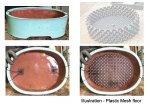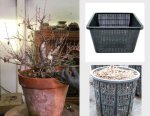Eric Group
Masterpiece
I love... LampI like puppies.
I love... LampI like puppies.
Square drain holes tend to crack more often during firing. @hometeamrocker mentioned this in a thread some time ago I think.Just wondering ...
View attachment 124142
Pots with square / rectangular holes do exist but very rare.
View attachment 124143
Square drain holes tend to crack more often during firing. @hometeamrocker mentioned this in a thread some time ago I think.
Yes, manual root pruning solves the circling problem (after the problem has developed) but why create the problem at all, in the first place ? Is prevention better or cure ? Besides, manual pruning wastes lot of root mass & growth time bcos of the need to keep roots short. Air-pruning of roots, on the other hand, keeps the roots not only short but also more densely packed and wastage is minimized during repotting. It works 24x7x365 unlike your once a year traditional repotting system.


can we collectively stop asking to see someone's trees as if it actually is a way to quantify knowledge or ability? Anyone can buy a nice tree, and people can understand soil and pot physics without ever actually having grown anything, if they are willing. Also, never has someone shown a tree under these circumstances and the rest of the posters swung their opinions because the tree was so great xyz must know what they are doing lol. Never. Knowledge of a topic does not necessarily equate to great trees, and great trees don't necessarily equate to knowledge of a topic.


I can assure you that growth of any plant hits it's peak when the roots hit the side of the pot and start to encircle the inside. That's why air pruning is only an advantage if you intend to take the plant out and move it into a larger one without touching the roots. Otherwise, you will get faster growth in a normal pot. If you want to slow growth a bit and have to water more then your pots will work fine. If you are growing to replant without root pruning, your pots will also work fine. Encircling roots in a container only slows down growth when they are so dense that they interfere with water, air and nutrient uptake. We repot before that happens. Certain nutrients like Fe and Ca are only taken up at the root tip. For continuous healthy growth we want to preserve the root tips as much as possible and not force the plant to constantly have to produce new ones all the time. It's like constant pinching, pinching pinching the leaves. It weakens plants. Sometimes nearly kills them. You need to them grow, THEN cut. Let grow THEN cut. That's the way to maintain vigor in the tree. Same with the roots. Let them grow, let them elongate as much as possible and the tree will thank you.
It makes no diffetence if it takes the pot 30 seconds or two minutes to drain the excess water. The amount of aeration is the same.
You are confusing the concepts of air pruning with air pruning. Two separate issues.
If you really want to grow seedlings fast, neither a bonsai pot nor a collapsed nor an air pot should be used. Growing in the ground is the fastest!
That said, fastest isn't necessarily best. Fast growing creates long internodes, and coarse thick roots. Neither of which are desirable bonsai characteristics. We want short internodes, a tapering trunk, lots of feeder roots close to the trunk.
Frequent repotting does indeed slow the tree down. But it allows us the opportunity to keep the nebari balanced, prevent a "one-sided" root system, create a shallow radial rootball, prevent crossing roots, etc. There are techniques used to enhance the nebari, such as the Ebihara Technique that Scott documented in a thread here. The colander method for growing pines is particularly effective when growing Shohin since they will need to be in small pots. It's less effective when trying to create a larger tree. Because to get a large tree, the roots need to be allowed to run.
Some people start their seedling pines in collanders to get a good nebari started, then move them into the ground for a couple years to bulk up, then dig them up and put them back into collanders to rebuild a rootsystem close to the trunk.
The purpose of a bonsai pot is NOT to be used to grow bonsai. It's to maintain a bonsai. Bonsai pots restrict root growth. Helping to keep the tree small.
The next best thing to use if you can't grow in the ground is a grow box. Oversized do the roots can extend.
Bonsai Hunter, lighten up on the attitude. You've only been doing bonsai for a year. You think you "know". You don't. You don't know that you don't know. I've been doing bonsai 45 years. I'm still learning new things.
Scott is a professional geologist. He knows more about drainage than anyone else I know.
One year in, you need to listening to others, not trying to change things.

^^^Hopefully this is the end of the this thread.
Yes, Boon did soak up information from everywhere, and there were conflicts. To resolve the conflicts, he went to Japan to become an apprentice. To learn directly from the source. Many of the conflicts were resolved. Many of the early publications we have in English that were supposedly translations of Japanese magazine articles were mistranslated. They were first translated from Japanese to Spanish, and then from Spanish to English. No one knows if the translator(s) knew anything about bonsai.I largely agree with you and maybe I wasn't clear enough or you have misunderstood me on the issue of grow challenge. Anyways, I see scope for improvement in the pot design. Lets leave it at that. I will do some crazy experiments with cement & plastic combo. I admit I was thinking shohin all the time as i live in a apartment. I am aware ground growing is best too. But at some stage it needs to come out from there into a grow pot.
View attachment 124518
And I am just wondering why can't that pot be an air pruning one, instead of a regular plastic or clay pot of same volume. Yes, I am aware of your background & have read many of your threads with interest. Well, my attitude was light to begin with till i got some snobbish royalty to peasant talk from mr. soil expert
http://bonsaiboon.com/pages/about_message.html
"In my early days, the way I learned bonsai was to pick up information wherever I could.
I attended numerous events by visiting bonsai teachers who came to the local club for
demonstrations or workshops, but each teacher had a different way of doing things. I
witnessed presentations that involving heavy cut-back, wiring, styling, and repotting,
all at the same time. I tried to ask about those trees and the total bonsai process,
but these classes were focused on putting something together in an hour or two. I knew even
then that this was the wrong way to care for bonsai—and the wrong way to teach. As I became
more passionate about bonsai, I began to step back and think there had to be a better way."
I am also exploring a better pot design. Boon says he was soaking up info from everywhere, even if it seemed to conflict. Same is my story. But one of the students of Boon would consider my youtube acquired knowledge as something to scoff at, forgetting his own teacher's history & also forgetting there are other experts on youtube too.Boon comes across as a humble person in video. Can't say the same about mr. soil expert though. Pity.
Anyways, your final thoughts on the proposed pot with plastic mesh might be a good insight for me. Hopefully this is the end of the this thread.

